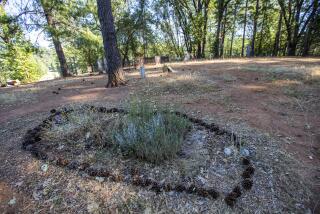In Dead of Winter, the Grave Blanket Business Heats Up
- Share via
DAGGETT, Mich. — In most of the Upper Peninsula, December is a slow time between the departure of leaf-gazing tourists and the invasion of the snowmobiles.
Yet it’s one of the busiest times of the year for perhaps 200 people scattered across the villages and pastures of Menominee County.
They make grave blankets--rectangular panels of evergreen boughs that are shipped to cemeteries, where they adorn burial plots through the winter. The work takes place during a hectic six- to eight-week period that generally runs from late October into December.
Crafting the blankets is “a tradition around here,” said Tom Kuntze of Daggett, who with his brother Dave has run the area’s biggest grave-blanket enterprise for 19 years.
“It gives people a way to make some money near the end of the year, when everybody needs to buy Christmas presents or pay the property taxes.”
The industry generates about $2 million a year locally, Kuntze said; his company typically grosses around $200,000. He employs 50 blanket makers, who work at 15 sites.
They’re paid according to how many they produce. An experienced blanket maker often clears $2,000 a year.
For Don Machalk Jr., who operates a grave blanket company down the road in Ingalls, production season comes just as his main business--manufacturing residential cedar fencing--slows down.
“It lets us keep the crew on full time,” Machalk said.
Grave blankets are used mostly in regions where winters are cold but snowfall tends to be moderate. They’re a common sight in southeastern Michigan, for example, but are rare in the Upper Peninsula, where the ground can be snow-covered all winter long.
“I have one on my dad’s grave, but it isn’t done much around here,” Kuntze said.
The blankets are less practical in warmer climates, where the boughs quickly would turn brown. But Stephen Morgan, executive vice president of the American Cemetery Assn., said he occasionally sees them in his area. His group is based in Reston, Va., a suburb of Washington, D.C.
“It’s a custom that has grown up over the decades,” Morgan said. “It’s a nice touch, especially around the holidays, when many families visit the graves of their loved ones.”
Kuntze sells most of his blankets to cemeteries in Midwestern cities, particularly Chicago.
It’s unclear how putting blankets on burial plots got started. But it may have evolved from the Jewish custom of mounding graves--piling on extra dirt to elevate them above the surrounding terrain, said Jim Sullivan, manager of Memorial Park Cemetery in Skokie, Ill. He is one of Kuntze’s top customers.
Few cemeteries allow mounding today, Sullivan said. To compensate, some people began putting floral and other plant arrangements atop their loved ones’ graves during the spring and summer.
“When the fall comes and the plants die, rather than leave the ground bare they put these evergreen blankets on so it will look nice through the fall and winter,” he said.
Tom and Dave Kuntze inherited the grave blanket business from their father, who started it in 1947.
Their busy season begins in early September, when they place advertisements offering to buy spruce and balsam boughs from Christmas tree growers, loggers and other suppliers.
“We’re recycling, in a sense,” Tom Kuntze said. “It prevents a tremendous waste of a resource.”
Grave blankets come in two basic styles. One has a rectangular frame made of cedar strips, to which the boughs are tied with plastic string. The other has no wooden frame; instead, the boughs are lashed to a layer of chicken wire.
Both types are around 5 feet long and 20 inches wide. This year, the Kuntzes began making smaller models for sale to pet cemeteries, where demand is picking up.
Once production starts, Kuntze arranges for delivery of boughs, frames, wire and other supplies to his workers. Families, friends and neighbors often get together to make blankets, working in garages, barns and elsewhere.
Kuntze’s operation produced about 23,000 blankets this year, up from 13,000 a decade ago.
Cemeteries often add pine cones, bows or other embellishments and can spray the blankets to enhance their color. A blanket will sell for $30 to $69.
Given the right mixture of cold weather and snow or rain, a blanket will stay green until late February or early March, Sullivan said.
Then the blanket heads for its own final destination: the shredding machine.
More to Read
Inside the business of entertainment
The Wide Shot brings you news, analysis and insights on everything from streaming wars to production — and what it all means for the future.
You may occasionally receive promotional content from the Los Angeles Times.










